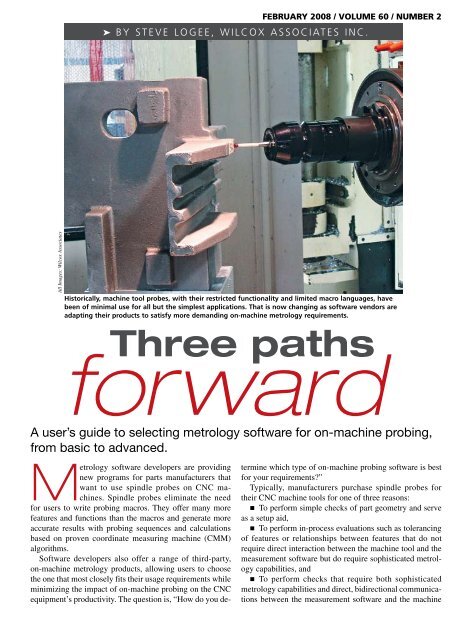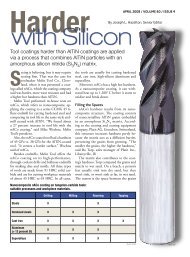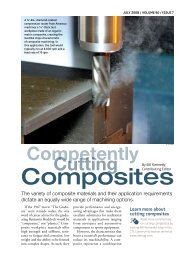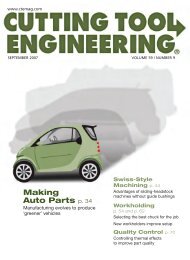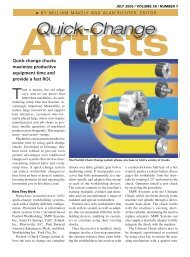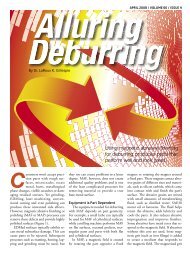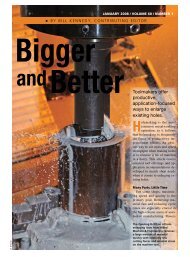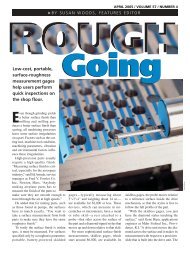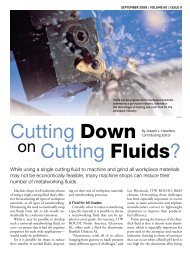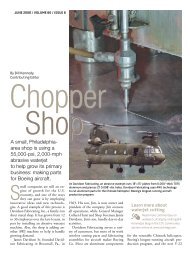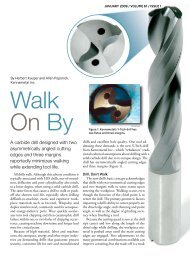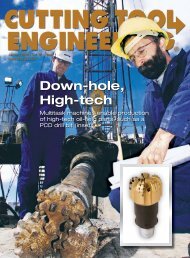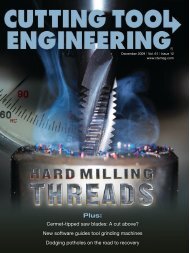0802-MetrologySoftwa.. - Cutting Tool Engineering
0802-MetrologySoftwa.. - Cutting Tool Engineering
0802-MetrologySoftwa.. - Cutting Tool Engineering
You also want an ePaper? Increase the reach of your titles
YUMPU automatically turns print PDFs into web optimized ePapers that Google loves.
All Images: Wilcox Associates<br />
➤ B Y S t e v e l o g e e , w i l c o x A S S o c i At e S i n c .<br />
Metrology software developers are providing<br />
new programs for parts manufacturers that<br />
want to use spindle probes on CNC machines.<br />
Spindle probes eliminate the need<br />
for users to write probing macros. They offer many more<br />
features and functions than the macros and generate more<br />
accurate results with probing sequences and calculations<br />
based on proven coordinate measuring machine (CMM)<br />
algorithms.<br />
Software developers also offer a range of third-party,<br />
on-machine metrology products, allowing users to choose<br />
the one that most closely fits their usage requirements while<br />
minimizing the impact of on-machine probing on the CNC<br />
equipment’s productivity. The question is, “How do you de-<br />
FEBRUARY 2008 / VOLUME 60 / NUMBER 2<br />
Historically, machine tool probes, with their restricted functionality and limited macro languages, have<br />
been of minimal use for all but the simplest applications. That is now changing as software vendors are<br />
adapting their products to satisfy more demanding on-machine metrology requirements.<br />
Three paths<br />
forward<br />
A user’s guide to selecting metrology software for on-machine probing,<br />
from basic to advanced.<br />
termine which type of on-machine probing software is best<br />
for your requirements?”<br />
Typically, manufacturers purchase spindle probes for<br />
their CNC machine tools for one of three reasons:<br />
n To perform simple checks of part geometry and serve<br />
as a setup aid,<br />
n To perform in-process evaluations such as tolerancing<br />
of features or relationships between features that do not<br />
require direct interaction between the machine tool and the<br />
measurement software but do require sophisticated metrology<br />
capabilities, and<br />
n To perform checks that require both sophisticated<br />
metrology capabilities and direct, bidirectional communications<br />
between the measurement software and the machine
tool’s controller.<br />
A Basic Solution<br />
Most spindle probe purchasers do not expect to use the<br />
probes for sophisticated metrology applications. Rather,<br />
they use them as aids for part and machine setup and to<br />
make simple checks on basic geometries.<br />
For setup, these users generally measure a few features<br />
and use the data to calculate and set tool and work offsets.<br />
In checking geometry, they use probes to check a few features<br />
in-process to make sure nothing is grossly wrong. For<br />
heavy-duty metrology and reporting, these users typically<br />
rely on CMMs.<br />
Speed and accuracy are vital for these users. CNC machine<br />
operators need to get checks done quickly and be able<br />
to rely on this data to make basic manufacturing decisions.<br />
This category of on-machine measurement generally requires<br />
software that is easier to use and more robust than the<br />
probing macros typically supplied by probe manufacturers.<br />
To meet these basic on-machine measurement needs,<br />
metrology software developers create user-friendly products<br />
for spindle probes. At minimum, these products incorporate<br />
icon-based graphic user interfaces and table-driven data<br />
entry routines that make it easy for operators to select and<br />
set up probing sequences and measurement evaluations.<br />
This basic on-machine measurement software isolates operators<br />
from the complexities and potential errors associated<br />
with manually entering data into cryptic macro calls.<br />
Most spindle probe purchasers do not<br />
expect to use the probes for sophisticated<br />
metrology applications. Rather, they use<br />
them as aids for part and machine setup<br />
and to make simple checks on basic<br />
geometries.<br />
Some of these products may include metrology algorithms<br />
certified by groups such as the national metrology<br />
institute Physikalisch-Technische Bundesanstalt, Braunschweig,<br />
Germany. These algorithms evaluate measurement<br />
data and provide operators with control over the placement<br />
and density of probe touches (two features lacking in basic<br />
probing macros). In addition, some products can format and<br />
produce basic reports, save probing sequences for subsequent<br />
use and store measurement information for additional<br />
analysis by other software.<br />
For most NC probe users, a set of basic measurement and<br />
setup tools is all they will ever need.<br />
The Middle Way<br />
Other users, however, require richer on-machine measurement<br />
and analysis software that offers advanced metrology<br />
and statistical process control tools for tasks such<br />
as analyzing machine performance, measuring large parts<br />
Basic Solution: PC-DMIS Lite from Wilcox Associates provides<br />
a core set of certified measurement and alignment algorithms<br />
driven by a graphic user interface. This software will be sold<br />
directly by CNC machinery builders and will be commercially<br />
available in the last quarter of 2008.<br />
that are either impossible or very difficult to measure on a<br />
CMM, calculating complex alignments and monitoring the<br />
quality of their parts as they are made. For these users, onmachine<br />
metrology features, functions and flexibility typical<br />
of advanced CMM software offer the best solution.<br />
This mode of on-machine metrology does not
typically require the user to operate his<br />
machine tool as if it were a CMM. In<br />
many cases, that would be more of a<br />
drawback than an advantage because<br />
the time spent taking measurements<br />
and analyzing them would reduce chip<br />
producing time. For many on-machine<br />
metrology applications, though, there<br />
is a middle way that allows users to<br />
develop part programs, execute them,<br />
analyze them and report the results<br />
with minimal impact on the manufacturing<br />
process.<br />
To create this middle way, CMM<br />
software developers have adapted their<br />
core software to the on-machine measurement<br />
environment by limiting the<br />
work done on the CNC to part probing.<br />
Everything else happens offline.<br />
In much the same way CAM systems<br />
work, offline programming packages<br />
generate the G and M codes needed to<br />
drive a probe. When these routines run<br />
on the machine tool, they use either a<br />
Middle Way: With PC-DMIS NC Server, measurement data collected by the spindle<br />
probe is processed offline in batch mode. This reduces the time spent on the<br />
machine tool controller for measurement and simultaneously gives users a set of<br />
measurement, analysis and reporting capabilities. A single software license can<br />
support multiple CNC machines.<br />
serial or network port to send the data<br />
they generate to a separate computer<br />
for processing. Here, the core metrol-<br />
ogy software accesses and evaluates<br />
the point files in batch format as they<br />
come from CNC machines. Using this
methodology, the only impact on machine<br />
time is the time spent taking<br />
points.<br />
This type of on-machine measurement<br />
product deals with data in<br />
batches, so it can concurrently manage<br />
and analyze data coming from multiple<br />
machine tools. The offline programming<br />
software generates probing sequences<br />
customized for the specific<br />
machine tools on which they will be<br />
used. On the back end, the analytical<br />
engine pairs the machine with its data<br />
files and matches that data with the appropriate<br />
part program.<br />
Users who have purchased the core<br />
software system can usually connect it<br />
to additional CNC machines without<br />
incurring substantial additional costs.<br />
This type of on-machine measurement<br />
system may be able to support<br />
a number of machines, depending on<br />
the volume of data coming from the<br />
machines and the topography of the<br />
user’s network.<br />
The middle approach offers users<br />
the benefit of adding measurement and<br />
programming capabilities along with<br />
analysis and reporting functions, while<br />
minimizing the factors that can retard<br />
machining output.<br />
Full CMM-Like Operation<br />
In addition to requiring a full range<br />
of metrology functions, some applications<br />
also demand a software solution<br />
that is directly integrated with the<br />
machine tool. This approach provides<br />
capabilities similar to those described<br />
above, but also allows for direct communication<br />
between the measurement<br />
software and the machine tool during<br />
program execution. This makes<br />
it possible to take advantage of such<br />
functions as iterative alignments, relative<br />
measurements and adjustments to<br />
program execution based upon conditional<br />
logic.<br />
In these cases, the machine tool runs<br />
almost like a CMM. The software that<br />
CMM software vendors offer for these<br />
applications is typically a direct adaptation<br />
of their standard products. The<br />
probing software controls the machine<br />
tool as if it were a CMM. It is even<br />
possible for the software to compensate<br />
for the machine’s volumetric inac-
curacies and temperature variations as<br />
if the machine were a high-accuracy<br />
CMM. With the exception of manually<br />
driving the probe to collect data<br />
points, which is a cumbersome process<br />
on a CNC machine, this measurement<br />
software behaves much as it does on a<br />
measurement machine.<br />
Because of its interactive nature,<br />
the impact of this software solution on<br />
cutting is greater than the batch-mode<br />
solution. This is true not only when<br />
measurements are being taken but also<br />
while the software is evaluating data<br />
and generating reports because everything<br />
is done on the machine. However,<br />
for many applications, the trade-off in<br />
time lost is more than made up for by<br />
the increase in machine functionality.<br />
Metrology software developers have<br />
addressed the diverse requirements of<br />
on-machine gaging. As a result, users<br />
can now select from a range of software<br />
products to hone in on feature sets that<br />
most closely fit their intended uses.<br />
For most applications, the only thing<br />
needed is a basic set of inexpensive<br />
and easy-to-use measurement software<br />
tools for locating parts, calculating<br />
offsets and evaluating basic geometry.<br />
The most important things in this case<br />
are that the on-machine probing software<br />
be easy to use and metrologically<br />
accurate.<br />
For more advanced applications requiring<br />
sophisticated metrology and<br />
reporting functions, the choice is be-<br />
Full CMM-Like Operation: PC-DMIS NCi interactive on-machine gaging software from<br />
Wilcox Associates assumes full control of the machine tool during measurement and<br />
analysis. This means the CNC machine can do almost anything a CMM can do.<br />
tween software systems that capture<br />
raw measurement data at the machine<br />
but process it offline and interactive<br />
products that assume complete control<br />
of the machine tool during the measurement<br />
and analysis process.<br />
If real-time interactivity between the<br />
metrology software and the machine<br />
tool is not required, the batch-mode,<br />
offline solution is more cost effective.<br />
However, in specific situations,<br />
interactive systems may be the only<br />
way to get the job done. This solution<br />
costs more than other approaches because<br />
separate software licenses may<br />
be required for each CNC machine,<br />
and cutting operations are interrupted<br />
while measurements and analyses are<br />
underway. If on-machine gaging is<br />
the only choice, though, the additional<br />
cost of the interactive approach is well<br />
worth it. q<br />
About the Author<br />
Steve Logee is director of business<br />
development for Wilcox Associates<br />
Inc., North Kingstown, R.I., a Hexagon<br />
Metrology company. He has been<br />
involved in the metrology industry for<br />
20 years. For more information about<br />
the company’s PC-DMIS metrology<br />
software, call (401) 886-2981, e-mail<br />
info@wilcoxassoc.com or visit pcdmis-ems.com.<br />
CUTTING TOOL ENGINEERING Magazine is protected under U.S. and international copyright laws.<br />
Before reproducing anything from this Web site, call the Copyright Clearance Center Inc. at (978) 750-8400.


